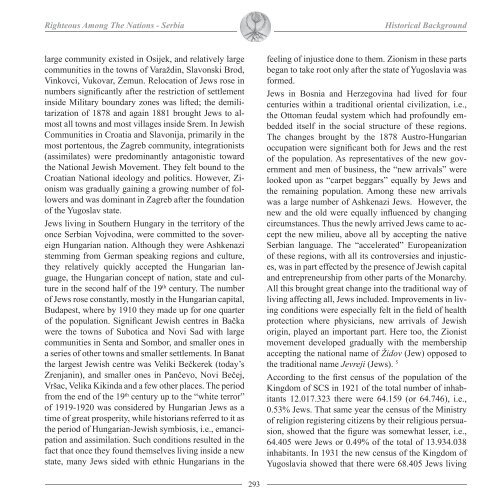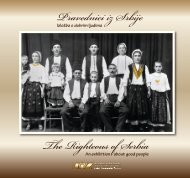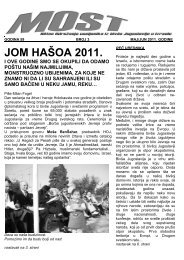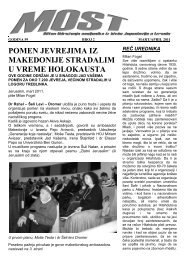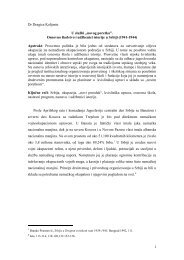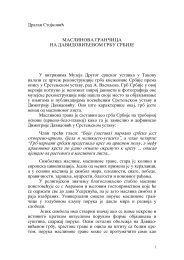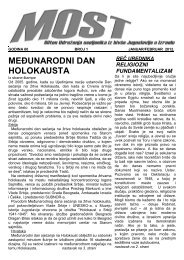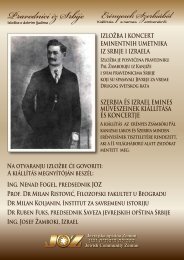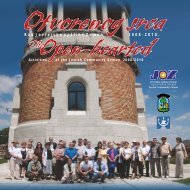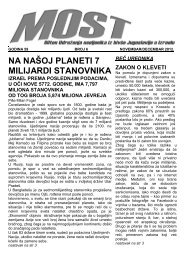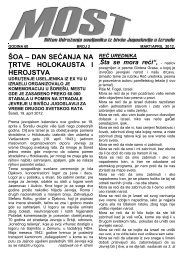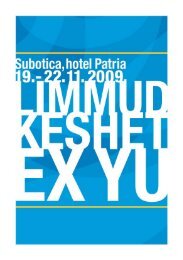Book on the Righteous - Jevrejska opština Zemun
Book on the Righteous - Jevrejska opština Zemun
Book on the Righteous - Jevrejska opština Zemun
You also want an ePaper? Increase the reach of your titles
YUMPU automatically turns print PDFs into web optimized ePapers that Google loves.
<strong>Righteous</strong> Am<strong>on</strong>g The Nati<strong>on</strong>s - Serbia<br />
Historical Background<br />
large community existed in Osijek, and relatively large<br />
communities in <strong>the</strong> towns of Varaždin, Slav<strong>on</strong>ski Brod,<br />
Vinkovci, Vukovar, <strong>Zemun</strong>. Relocati<strong>on</strong> of Jews rose in<br />
numbers significantly after <strong>the</strong> restricti<strong>on</strong> of settlement<br />
inside Military boundary z<strong>on</strong>es was lifted; <strong>the</strong> demilitarizati<strong>on</strong><br />
of 1878 and again 1881 brought Jews to almost<br />
all towns and most villages inside Srem. In Jewish<br />
Communities in Croatia and Slav<strong>on</strong>ija, primarily in <strong>the</strong><br />
most portentous, <strong>the</strong> Zagreb community, integrati<strong>on</strong>ists<br />
(assimilates) were predominantly antag<strong>on</strong>istic toward<br />
<strong>the</strong> Nati<strong>on</strong>al Jewish Movement. They felt bound to <strong>the</strong><br />
Croatian Nati<strong>on</strong>al ideology and politics. However, Zi<strong>on</strong>ism<br />
was gradually gaining a growing number of followers<br />
and was dominant in Zagreb after <strong>the</strong> foundati<strong>on</strong><br />
of <strong>the</strong> Yugoslav state.<br />
Jews living in Sou<strong>the</strong>rn Hungary in <strong>the</strong> territory of <strong>the</strong><br />
<strong>on</strong>ce Serbian Vojvodina, were committed to <strong>the</strong> sovereign<br />
Hungarian nati<strong>on</strong>. Although <strong>the</strong>y were Ashkenazi<br />
stemming from German speaking regi<strong>on</strong>s and culture,<br />
<strong>the</strong>y relatively quickly accepted <strong>the</strong> Hungarian language,<br />
<strong>the</strong> Hungarian c<strong>on</strong>cept of nati<strong>on</strong>, state and culture<br />
in <strong>the</strong> sec<strong>on</strong>d half of <strong>the</strong> 19 th century. The number<br />
of Jews rose c<strong>on</strong>stantly, mostly in <strong>the</strong> Hungarian capital,<br />
Budapest, where by 1910 <strong>the</strong>y made up for <strong>on</strong>e quarter<br />
of <strong>the</strong> populati<strong>on</strong>. Significant Jewish centres in Bačka<br />
were <strong>the</strong> towns of Subotica and Novi Sad with large<br />
communities in Senta and Sombor, and smaller <strong>on</strong>es in<br />
a series of o<strong>the</strong>r towns and smaller settlements. In Banat<br />
<strong>the</strong> largest Jewish centre was Veliki Bečkerek (today’s<br />
Zrenjanin), and smaller <strong>on</strong>es in Pančevo, Novi Bečej,<br />
Vršac, Velika Kikinda and a few o<strong>the</strong>r places. The period<br />
from <strong>the</strong> end of <strong>the</strong> 19 th century up to <strong>the</strong> “white terror”<br />
of 1919-1920 was c<strong>on</strong>sidered by Hungarian Jews as a<br />
time of great prosperity, while historians referred to it as<br />
<strong>the</strong> period of Hungarian-Jewish symbiosis, i.e., emancipati<strong>on</strong><br />
and assimilati<strong>on</strong>. Such c<strong>on</strong>diti<strong>on</strong>s resulted in <strong>the</strong><br />
fact that <strong>on</strong>ce <strong>the</strong>y found <strong>the</strong>mselves living inside a new<br />
state, many Jews sided with ethnic Hungarians in <strong>the</strong><br />
feeling of injustice d<strong>on</strong>e to <strong>the</strong>m. Zi<strong>on</strong>ism in <strong>the</strong>se parts<br />
began to take root <strong>on</strong>ly after <strong>the</strong> state of Yugoslavia was<br />
formed.<br />
Jews in Bosnia and Herzegovina had lived for four<br />
centuries within a traditi<strong>on</strong>al oriental civilizati<strong>on</strong>, i.e.,<br />
<strong>the</strong> Ottoman feudal system which had profoundly embedded<br />
itself in <strong>the</strong> social structure of <strong>the</strong>se regi<strong>on</strong>s.<br />
The changes brought by <strong>the</strong> 1878 Austro-Hungarian<br />
occupati<strong>on</strong> were significant both for Jews and <strong>the</strong> rest<br />
of <strong>the</strong> populati<strong>on</strong>. As representatives of <strong>the</strong> new government<br />
and men of business, <strong>the</strong> “new arrivals” were<br />
looked up<strong>on</strong> as “carpet beggars” equally by Jews and<br />
<strong>the</strong> remaining populati<strong>on</strong>. Am<strong>on</strong>g <strong>the</strong>se new arrivals<br />
was a large number of Ashkenazi Jews. However, <strong>the</strong><br />
new and <strong>the</strong> old were equally influenced by changing<br />
circumstances. Thus <strong>the</strong> newly arrived Jews came to accept<br />
<strong>the</strong> new milieu, above all by accepting <strong>the</strong> native<br />
Serbian language. The “accelerated” Europeanizati<strong>on</strong><br />
of <strong>the</strong>se regi<strong>on</strong>s, with all its c<strong>on</strong>troversies and injustices,<br />
was in part effected by <strong>the</strong> presence of Jewish capital<br />
and entrepreneurship from o<strong>the</strong>r parts of <strong>the</strong> M<strong>on</strong>archy.<br />
All this brought great change into <strong>the</strong> traditi<strong>on</strong>al way of<br />
living affecting all, Jews included. Improvements in living<br />
c<strong>on</strong>diti<strong>on</strong>s were especially felt in <strong>the</strong> field of health<br />
protecti<strong>on</strong> where physicians, new arrivals of Jewish<br />
origin, played an important part. Here too, <strong>the</strong> Zi<strong>on</strong>ist<br />
movement developed gradually with <strong>the</strong> membership<br />
accepting <strong>the</strong> nati<strong>on</strong>al name of Židov (Jew) opposed to<br />
<strong>the</strong> traditi<strong>on</strong>al name Jevreji (Jews). 5<br />
According to <strong>the</strong> first census of <strong>the</strong> populati<strong>on</strong> of <strong>the</strong><br />
Kingdom of SCS in 1921 of <strong>the</strong> total number of inhabitants<br />
12.017.323 <strong>the</strong>re were 64.159 (or 64.746), i.e.,<br />
0.53% Jews. That same year <strong>the</strong> census of <strong>the</strong> Ministry<br />
of religi<strong>on</strong> registering citizens by <strong>the</strong>ir religious persuasi<strong>on</strong>,<br />
showed that <strong>the</strong> figure was somewhat lesser, i.e.,<br />
64.405 were Jews or 0.49% of <strong>the</strong> total of 13.934.038<br />
inhabitants. In 1931 <strong>the</strong> new census of <strong>the</strong> Kingdom of<br />
Yugoslavia showed that <strong>the</strong>re were 68.405 Jews living<br />
293


